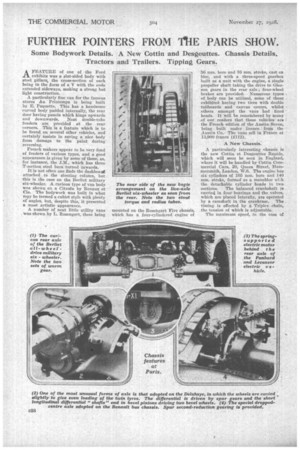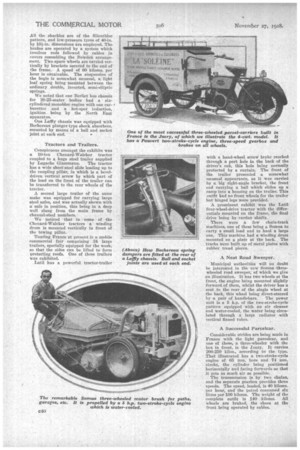FURTHER POINTERS FROM ThE PARIS SHOW.
Page 22

Page 23

Page 24

Page 25

If you've noticed an error in this article please click here to report it so we can fix it.
Some Bodywork Details. A New Cottin and Desgouttes. Chassis Details. Tractors and Trailers. Tipping Gears.
AFEATURE of one of the Ford exhibits was a plat-sided body with steel pillar; the cross-section of each being in the form pf a V with the ends extended sideways, making a strong but light construction.
A particularly fine van for the famous stores Au Printemps is being built by E. Paquette. This has a handsome curved body padded internally, the rear door having panels which hinge upwards and downwards. Neat double-tube fenders are provided at . the rear corners. This is g feature which is to be found on several other vehicles, and certainly assists in saving a nice body from damage to the paint during reversing.
French makers appear to be very fond of fenders of various types, and a good appearance is given by some of these; as, for instance, the J,M., which has three T-seetion steel bars turned inwards.
It' is not often one finds the dashboaai attached to the steering column, but, this is the case on the 33erliet military six-wheeler. A curious type of van body was shown on a CitnAn by Renaux et Cie. The bodywork was built in what may be termed a cubist style with plenty of angles, but, despite this, it presented a most artistic appearance.
A number of neat little utility vans was shown by L. Rosengart, these being mounted on the Rosengart Five chassis, which has a four-cylindered engine of
• 56 ram. bore and 76 mm. stroke, cast en bloc, and with a three-speed gearbox built as a unit with the engine, a single propeller shaft taking the drive to Gleason gears in the rear axle ; four-wheel brakes are provided. Numerous types of body Can he utilized, some of those : exhibited having two tiers With double tailboards and Canvas covers, whilst : others amongst the vans had fixed . heads. :It Will be remembered by many of our readers that these vehicles the French edition of the Austin Seven, being built under licence from the Austin Co. The vans sell in France at 13,900 francs (£112).
A New Chassis.
A particularly interesting chassis is the new Cottin, et Desgouttes Rapide, which will soon be aeon in England, where it will be handled by Cottin Commercial Cars, 20, Queen' Street, Hammersmith, London NV.6. The engine has six cylinders of 1:05 mm. bore and 140 mm. stroke, formed as a monobloc with the detachable cylinder heads hi two sections. The balanced crankshaft is carried in four bearings and the valves, which are placed laterally, are operated by a camshaft in the crankcase. The timing is effected by a Triplex chain, the tension of which is adjustable.
The maximum speed, in the case of the vehicle which we saw, was controlled by a centrifugal governor situated at the side of the carburetter and operated by the camshaft ; tampering with this governor is impossible. Two gear-type pumps submerged in oil supply the bearings under pressure; et er pump can deal with the necessary I eation, the second is a precautionar zasttre.
The oil is constantly circulate "Through a radiator. There are two sparking plugs per cylinder and two distinct systems of ignition, these being battery coil and distributor and magneto.
The engine and four-speed gearbox are built as a unit with the multiple
plate steel and Ferodo clutch. The speeds are controlled by a centrally positioned lever, a two-piece propeller shaft taking the drive to adoublereduction bevel-and-spur-gear axle. This reduction can be supplied in three ratios, viz., 1 to 7.5, 1 to 6 and 1. to 5, permitting speeds of from 60 kiloms, per hour to 90 kiloms. per hour in top gear.
The steering has been laid out with a view to giving the greatest safety. There is a shaft mounted transversely on the chassis. At each end of this is fixed a lever which transmits its movement to its individual wheel by means of a ball joint; a coupling bar is also provided between the wheels so that in the case of a fracture of one lever, steering is still effective. There are three brakes, a foot brake on the transmission, a foot brake on the four wheels with Perrot Bendix shoes operated through a Dewandre servo, and a hand lever acting on the rear wheels only.
The Rochet-Schneider coach chassis has a long torque tube bearing on the forward end of the propeller shaft immediately behind the gearbox. The axle is a double-reduction pattern with underslung springs, and a gate is mounted on the gearbox cover instead of the usual ball-change device.
In the new De Dion, model LC., the fan and dynamo are combined and driven by a single endless belt.
We have already referred to the Miesse six-wheeler with eight-cylinderin-line engine. One of these chassis,
with a particularly comfortable 20-seater body, WRS running about outside the Show. The chief interest about this vehicle was that it is one built for the Nairn Transport Co. for cross-desert service. It has twin-tyred wheels throughout, eight speeds and a body raised 2 ft. higher than normal to permit a fair amount of luggage to be carried underneath it. The chassis shown had a forward dash, giving a large loading space.
It may be remembered that the Mimic eight-cylindered engine was described some months ago in The Commercial Motor. It embodies an overhead camshaft driven by a Coventry chain, and two carburetters. The bore and stroke of the engine are 80 mm. and 130 mm., respectively, giving a b.h.p. of 101.
Reverting to the chassis as a whole, it has brakes operating on all six wheels, the shoes being of the servo pattern; a four-speed gearbox mounted as a unit with the engine and a two-piece propeller shaft taking the drive to underneath worms and pot-type axle casings. All the shackles are of the Silenthloe pattern, and low-pressure tyres of 40-in. by 101-in. dimensions are employed. The brakes are operated by a system which involves rods followed by cables in covers resembling the Ho'wild]. arrangement. Tivo spare wheels are carried vertically by brackets secured to the end of the frame.. A speed of 80 kiloms. per hour is obtainable. The suspension of the bogie is somewhat unusual, a light leaf spring being Mounted between the ordinary double, inverted, semi-elliptic springs.
. We noted that one Berliet bus chassis for 29-25-seater bodies had a sixcylindered monobloc engine with one car-' buretter and a hot-spot induction, ignition . being by the North East apparatus.
One Laiily chassis was equipped with Bechereau plunger-type shock absorbers, mounted by means of a ball and socket joint at each end.
Tractors and Trailers.
Conspicuous amongst the exhibits was a 10-ton Chenard-Walcker tractor coupled to a huge steel trailer supplied by Lagache Glaszmann. The tractor has a wide sheet-steel slide leading up to the coupling pillar, in which is a bevel' driven vertical screw by which part of the load on the front of the trailer can be transferred to the rear wheels of the tractor.
A second large trailer of the same make was equipped for carrying large steel safes, and was actually shown with a safe in position, this being in a deep well slung from the main frame by channel-steel members.
We noticed that in some of the Chenard-Waleker tractors a winding drum is mounted vertically in front of the towing pillar.
Touring France at present is a mobile commercial fair comprising 31 large trailers, specially equipped for the work, so that the sides can be lifted to form protecting roofs. One of these trailers was exhibited.
Latil has a powerful tractor-trailer
with a hand-wheel screW brake reached through a port hole in the back of the driver s cab, this 'hole being normally, Protected by a curtain. The front of the trailer presented a somewhat unusual appearance, as it VMS carriedby a big Tight-angle bracket, the front end carrying a ball which slides up a ramp into a housing on the trailer. This outfit had no front wheels for the trailer but hinged legs were provided.
A prominent exhibit was the Lathl four-wheel-drive tractor with the differentials mounted on the frame, the final drive being by cardan shafts.
There were a few chain-track Machines, one of these being a Somua to carry a small load and to haul a large one This machine had a winding drum mounted on a plate at the back. The tracks were builtup of metal plates with rubber tread pieces.
A Neat Road .Sweeper.
Municipal authorities will DO doubt be interested in the iie liomna threewheeled 'road sweeper, of which we give an illdstration. It has two wheels at the front, the engine being mounted slightly forward of them, whilst the driver has a seat to the rear of the single wheel -at the back, this wheel being direct-steered by a pair of handlebars. The power unit is a 5 h.p. of the two-stroke-cycle pattern equipped with an air cleaner and water-cooled, the water being circu-lated through a large radiator with vertical finned tubes.
A Successful Parcelear.
Considerable strides are being made in France with the light parcelcar, and one of these, a three-wheeler with the box in front, is the Jeers,. It carries 200-259 kilos., according to the type. Unit illustrated has a two-stroke-cycle engine of 65 mm. bore and 74 rum. stroke, the cylinder being positioned horizontally and facing forwards so that it gets as much air as possible.
The transmission is by two chains, and the separate gearbox provides three speeds. The speed, loaded, is 40 Moms. per hour, and the petrol consumed six litres per 109 kiloans. The weight of the complete outfit is 140 kiloms. All wheels are braked, the shoes at the front being operated by cables. Tipping Gears.
There did not seem to be much new in the way of tipping gears. The Mousset side-tipping pattern has two pairs of racks in tilting frames with the drive taken right through both by a shaft turned by a chain from a sprocket clutch to the layshaft of the gearbox. Each individual rack of a pair is joined to the other rack by a bracket at the top, this carrying a ball resting in a socket on the body.
The Pilot gear is also on the rack principle, but, in this ease, the racks are curved and are hand-operated by a reducing gear situated at the side of the chassis.
The Paquette trailer has a roll-over tipping action, whilst in the Geneve gear a horizontal ram forces rollers under cam-shaped runners on the body. Finally, there was the La Triverse threeway pattern, which has two telescopic rams in a swivel frame, these rams being joined at the top by a curved member which can slide in a channel mounted on the body. This sliding, of course, occurs only when the body is being tipped to either side. The gear is suitable for operation by hand or power. In , the case of the former. a hand crank is utilized to drive the pump.


































